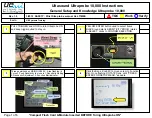
7-2
Status Structure
Models 2510 and 2510-AT User’s Manual
Overview
The Model 2510 provides a series of status registers and queues allowing the operator to
monitor and manipulate the various instrument events. The status structure is shown in
. The heart of the status structure is the Status Byte Register. This register can be
read by the user’s test program to determine if a service request (SRQ) has occurred, and
what event caused it.
Status byte and SRQ
The Status Byte Register receives the summary bits of four status register sets and two
queues. The register sets and queues monitor the various instrument events. When an
enabled event occurs, it sets a summary bit in the Status Byte Register. When a summary
bit of the Status Byte is set and its corresponding enable bit is set (as programmed by the
user), the RQS/MSS bit will set to indicate that an SRQ has occurred.
Status register sets
A typical status register set is made up of a condition register, an event register and an
event enable register. A condition register is a read-only register that constantly updates to
reflect the present operating conditions of the instrument.
When an event occurs, the appropriate event register bit sets to 1. The bit remains latched
to 1 until the register is reset. When an event register bit is set and its corresponding enable
bit is set (as programmed by the user), the output (summary) of the register will set to 1,
which in turn sets the summary bit of the Status Byte Register.
Queues
The Model 2510 uses an Output Queue and an Error Queue. The response messages to
query commands are placed in the Output Queue. As various programming errors and sta-
tus messages occur, they are placed in the Error Queue. When a queue contains data, it sets
the appropriate summary bit of the Status Byte Register.
Summary of Contents for TEC SourceMeter 2510
Page 194: ...A Specifications...
Page 197: ...B StatusandErrorMessages...
Page 206: ...C IEEE 488BusOverview...
Page 221: ...D IEEE 488andSCPI ConformanceInformation...
Page 225: ...E ExamplePrograms...
Page 233: ...F GPIB488 1Protocol...
















































